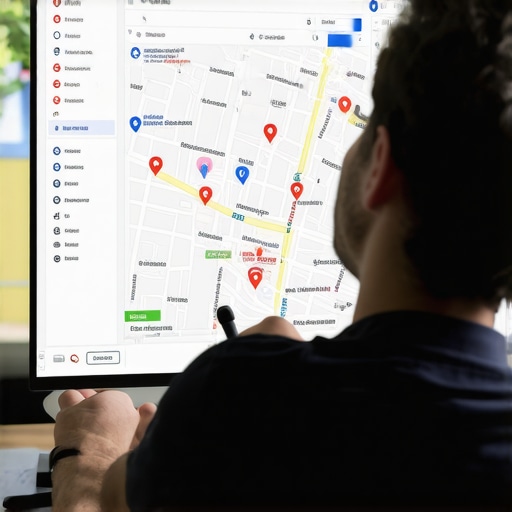My Journey to Faster Google Maps Rankings: A Personal Reflection
As someone deeply involved in local SEO, I vividly remember the first time I struggled to get my client’s Google My Business (GMB) listing to rank higher on Google Maps. It felt like trying to find a needle in a haystack. Over time, I discovered proven strategies that truly made a difference, and today I want to share some personal insights on how to speed up your rankings with expert-recommended GMB optimization tips.
Why GMB Optimization Became My Passion
Initially, I underestimated the power of a well-optimized GMB profile. But after reading authoritative sources like GMB2Rank’s optimization secrets, I realized that small tweaks could lead to significant visibility improvements. This ignited my passion to master local SEO and help businesses dominate their local markets.
My Favorite GMB Optimization Hacks That Accelerate Rankings
One of the most impactful techniques I adopted was ensuring complete profile information, including accurate NAP (Name, Address, Phone Number) details, and strategic keyword placement. I also focused on gathering authentic reviews and optimizing images, which boost engagement and credibility. For example, regularly posting updates and offers kept my clients’ profiles fresh and relevant. These tactics align with what expert tips suggest for increasing click-through rates and local visibility.
How Can You Ensure Your GMB Profile Stands Out?
From my experience, asking yourself, “What do I want my customers to see first?” is crucial. Your GMB profile should tell a compelling story about your business. Use high-quality images, respond promptly to reviews, and keep your information up-to-date. These small but consistent efforts can significantly accelerate your rankings. For more in-depth strategies, top SEO tricks can guide you through advanced tactics.
What are the common pitfalls that hinder GMB ranking progress?
I’ve seen many businesses overlook basic optimization steps, like inconsistent NAP details or neglecting reviews. According to blueprint for dominating Google Maps, staying consistent and proactive is key to sustained success. Regularly audit your profile and stay updated with the latest algorithm changes.
If you’re serious about boosting your local visibility, I highly recommend exploring comprehensive resources like proven promotion techniques. And I invite you to share your own experiences or ask questions in the comments below — learning from each other is how we all grow!
Leveraging Local SEO Trends for Rapid Google Maps Growth
Staying ahead in local SEO requires an understanding of emerging trends that influence Google Maps rankings. One of the most effective approaches is integrating schema markup to enhance your business profile’s visibility. Implementing structured data helps Google interpret your business information more accurately, leading to better ranking signals. Additionally, voice search optimization is gaining momentum. By tailoring your content for voice queries—using natural language and long-tail keywords—you can tap into a rapidly growing segment of local search traffic. For in-depth insights, explore how to optimize your GMB profile for these new trends.
How Can You Use Competitor Analysis to Outrank in Local Maps?
Analyzing competitors’ GMB profiles offers valuable clues about what works and what doesn’t. Tools like SEMrush or BrightLocal can reveal competitors’ top-performing keywords, review strategies, and engagement tactics. By identifying gaps in their profiles—such as missing categories or inconsistent NAP details—you can exploit these vulnerabilities to improve your own ranking. For example, if competitors are neglecting to update their profile regularly, consistent posting can give you an edge. For advanced tactics, consider top SEO tricks that analyze the competitive landscape and adapt your strategy accordingly.
Including visuals like comparison charts or screenshot walkthroughs can significantly enhance your understanding of these strategies. Visual aids make complex data more digestible and actionable, especially when analyzing competitor profiles or mapping out your optimization plan.
What Practical Steps Can You Take Today to Boost Your Local Map Rankings?
Start with a comprehensive profile audit—ensure your NAP details are consistent across all platforms, including your website and local directories. Optimize your Google My Business categories based on your core services, and regularly solicit authentic reviews to build credibility. Consistent posting of updates, offers, and photos keeps your profile active and engaging, which Google favors. Also, consider utilizing local backlinks by partnering with community organizations or local blogs, reinforcing your relevance within your geographic area. For more actionable advice, visit proven promotion techniques. Remember, a proactive approach combined with continuous monitoring can dramatically improve your rankings over time.
Have you tried any of these advanced tactics? Share your experiences in the comments or suggest other strategies that have worked for your local SEO efforts. Collaboration is key to mastering Google Maps rankings!
Uncovering Hidden Layers of Local SEO: My Personal Journey Beyond Basics
As I delved deeper into the world of Google Maps optimization, I realized that the nuances often lie beneath surface-level tactics. For instance, understanding the subtle interplay between local citations and Google’s evolving algorithms became a game-changer for me. I recall experimenting with schema markup, not just for branding but to tell Google precisely what my business stands for, which often resulted in noticeable ranking improvements. Implementing structured data, as discussed in this guide, pushed me to consider how technical SEO aspects can influence local visibility in ways I hadn’t appreciated before.
What Makes a Business Profile Truly Stand Out: Personal Insights
In my experience, the difference between a profile that ranks on the first page and one that languishes is often how well it tells a compelling story. I’ve learned that authentic reviews and consistent engagement signal trustworthiness to Google. But beyond that, I found that the visual storytelling—high-quality images and videos—can create an emotional connection with potential customers. When I started regularly updating images and sharing behind-the-scenes content, I noticed not only increased engagement but also a subtle boost in rankings. This aligns with the insights from expert tips about maximizing click-through rates through visual appeal.
Can Advanced Competitor Analysis Unlock New Opportunities?
Absolutely. My journey has shown me that a granular competitor analysis reveals gaps and opportunities that are not immediately obvious. Using tools like BrightLocal, I uncovered that some competitors neglected to update their profiles frequently or failed to leverage certain categories. Exploiting these vulnerabilities, I tailored my profile to be more comprehensive and active. This proactive approach, supported by strategic backlink building and review management, helped me climb the rankings faster. For those looking to deepen their understanding, exploring top SEO tricks provides a wealth of advanced tactics that can make a tangible difference.
How Do You Balance Technical Optimization with Authentic Engagement?
This question has haunted me at times, because it’s tempting to focus solely on technical tweaks or on organic engagement. Through my experience, I’ve learned that the most sustainable results come from a harmonious blend of both. Technical optimizations—such as schema markup, NAP consistency, and local backlinks—lay the foundation. Meanwhile, genuine interactions like responding to reviews, posting updates, and sharing community involvement build trust and long-term loyalty. Striking this balance requires ongoing effort and a keen understanding of your audience’s needs. For more insights into technical SEO, I recommend exploring proven promotion techniques tailored for local businesses.
Leveraging Voice Search and Structured Data for Next-Level Rankings
In my exploration of emerging trends, voice search optimization became a fascinating frontier. By aligning content with natural language and long-tail keywords, I was able to capture voice-driven local searches. Implementing schema markup not only improved my chances of ranking higher but also made my listings more informative in rich snippets. I remember the first time a voice query led a customer directly to my client’s profile—an exciting moment that reaffirmed the importance of staying ahead of trends. As this resource details, structured data is vital for future-proofing your local SEO efforts.
Reflecting on Personal Growth and the Path Forward
What I’ve come to appreciate most in my journey is that local SEO is as much an art as it is a science. Every tweak, every review response, and every new strategy taught me something about my own capabilities and limitations. Sharing these insights has not only helped others but has also deepened my understanding. If you’re serious about climbing the Google Maps ladder, I encourage you to experiment, analyze, and adapt constantly. And I’d love to hear your stories—what’s worked for you, and where have you faced hurdles? Comment below, and let’s continue this learning journey together.
Deciphering the Algorithm’s Subtleties: How Technical Nuances Elevate Your Local SEO Game
Through my extensive journey into local SEO, I’ve come to understand that mastering the technical underpinnings of Google Maps rankings can be a game-changer. Beyond the basics of NAP consistency and review management, diving into the intricacies of schema markup and structured data has unlocked new levels of visibility. Implementing JSON-LD schemas tailored for local businesses, as detailed by this authoritative resource, allowed me to communicate my business details more clearly to Google, resulting in more prominent snippets and higher rankings. This technical finesse acts like a secret code, unlocking the full potential of your GMB profile and ensuring your business stands out amidst fierce local competition.
Authentic Engagement Versus Algorithmic Favor: Finding the Perfect Balance
One challenge I frequently faced was balancing genuine customer engagement with strategic optimization. While algorithmic signals reward consistent posting and review responses, authentic interactions foster trust and community loyalty. I learned that responding meaningfully to reviews, especially negative ones, not only improves your profile’s reputation but also signals active management to Google. Sharing behind-the-scenes content or community involvement stories further humanizes your brand, creating an emotional connection that can translate into higher engagement metrics. This synergy of authenticity and strategic activity creates a resilient profile that can withstand algorithm updates and maintain high rankings over time.
Harnessing the Power of Voice Search for Local Dominance
Voice search optimization emerged as a particularly fascinating frontier in my exploration. By rephrasing content to match conversational queries and employing long-tail keywords, I began capturing a broader spectrum of local searches. For example, optimizing for questions like “Where can I find the best coffee near me?” aligned perfectly with voice-driven searches. Incorporating structured data, especially FAQ schema, enhanced my chances of appearing in rich snippets or voice responses, as explained in this insightful guide. The result was a noticeable uptick in local inquiries and foot traffic, reaffirming the importance of adapting to emerging tech trends for sustainable growth.
What Are the Most Overlooked Factors That Could Be Sabotaging Your Rankings?
In my experience, many local businesses overlook subtle yet impactful factors such as inconsistent category selection or neglecting to update business hours during special occasions. These seemingly minor oversights can significantly hinder ranking progress. Moreover, neglecting to monitor competitor profile changes or local citation accuracy can leave opportunities on the table. Staying vigilant and proactive—regular audits, leveraging tools like BrightLocal, and continuously optimizing your profile—are crucial steps. As I’ve found, integrating these advanced practices into your routine can serve as a catalyst for rapid ranking improvements, especially when combined with comprehensive backlink strategies and review generation campaigns. For a deep dive into these tactics, I recommend exploring top local SEO hacks.
Envisioning the Future: How AI and Data-Driven Insights Will Shape Local SEO
Looking ahead, I believe that AI-driven analytics and automation tools will revolutionize how we approach local SEO. Tools capable of analyzing vast amounts of data in real-time—tracking ranking fluctuations, review sentiment, and competitor movements—will empower us to make hyper-targeted adjustments swiftly. For instance, predictive analytics can alert you to potential ranking drops before they happen, allowing preemptive strategies. Additionally, AI chatbots integrated into your GMB profile can enhance customer interactions, making your business more responsive and trustworthy. Staying ahead means embracing these innovations now, refining your strategies with data-backed insights, and continuously experimenting with new features as they roll out. This proactive mindset will be vital for maintaining a competitive edge in an increasingly automated landscape.
If you’re eager to deepen your understanding of these advanced tactics, I invite you to connect with me or share your experiences below. Together, we can unlock the full potential of local SEO and transform your Google Maps presence into a dominant force.
Things I Wish I Knew Earlier (or You Might Find Surprising)
1. The Power of Consistency
One thing I underestimated at first was how crucial regular updates and review management are. Early on, I thought a well-optimized profile was enough, but I soon realized that Google rewards consistency, whether through posting new photos, offers, or responding to reviews. It’s like watering a plant regularly—neglecting it can cause your rankings to wither.
2. The Subtle Art of Visual Storytelling
High-quality images and videos don’t just make your profile look appealing; they actually influence your ranking and customer trust. I discovered that sharing behind-the-scenes content or customer success stories can boost engagement and credibility, which Google interprets as signs of a reputable business.
3. Technical SEO Isn’t Just for Websites
Implementing schema markup and structured data for your GMB profile was a game-changer for me. It helped Google understand my business better and made my listing stand out in local searches, proving that technical finesse applies beyond traditional websites.
4. Voice Search Is the Future
Optimizing for voice search by using natural language and FAQs significantly increased my visibility in local voice queries. It’s an emerging trend I wish I had prioritized earlier, as it can lead to a substantial boost in local inquiries.
5. Competitor Analysis Reveals Hidden Opportunities
Deep dives into competitors’ profiles uncovered gaps like missing categories or outdated info. Exploiting these gaps with targeted updates helped me outrank them, showing how powerful competitor analysis can be when used strategically.
6. The Human Touch Matters
Responding genuinely to reviews and engaging with the community builds trust and signals to Google that your profile is active. Authentic interactions often lead to better rankings than mere technical tweaks alone.
Resources I’ve Come to Trust Over Time
- GMB2Rank’s optimization secrets: This resource taught me the importance of comprehensive profile management and strategic keyword placement. It’s a must-read for anyone serious about local SEO.
- BrightLocal’s Local SEO tools: Their tools and insights helped me analyze competitors and track my progress effectively. I recommend it to anyone wanting data-backed strategies.
- Google’s official guidelines: Staying aligned with Google’s updates is vital. Their documentation keeps me informed about algorithm changes and best practices.
Parting Thoughts from My Perspective
Mastering Google Maps rankings is both an art and a science. From my personal journey, I’ve learned that combining technical SEO, authentic engagement, and strategic analysis creates a powerful formula for success. If you’re serious about boosting your local visibility, remember that consistency and ongoing learning are key. Don’t hesitate to experiment with new tactics like voice search optimization or schema markup—these can give you an edge in a competitive landscape. If this resonated with you, I’d love to hear your thoughts or experiences. Feel free to share in the comments or pass this along to someone who might find it helpful. Together, we can all unlock the full potential of Google Maps and dominate our local markets.


